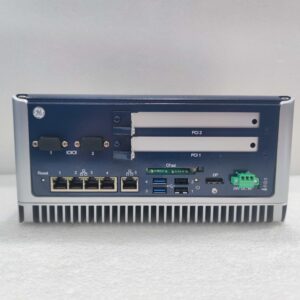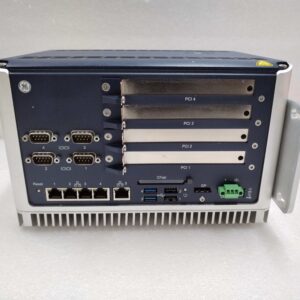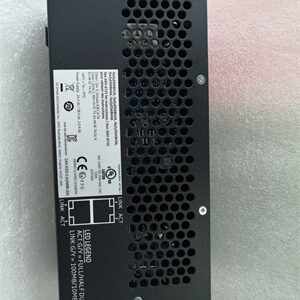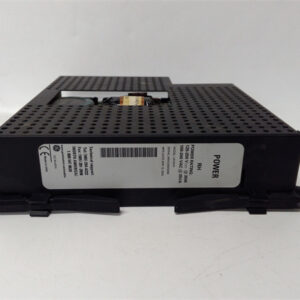Description
Detailed Parameter Table
| Parameter Name | Parameter Value |
| Product Model | IS200EISBH1A |
| Manufacturer | General Electric (GE) |
| Product Category | Excitation I/O System Bus Hub Module (EX2100 Excitation Control Series) |
| Core Function | Distributed I/O signal aggregation; bus protocol conversion; signal isolation; remote device management |
| Supported Bus Protocols | GE EX2100 I/O Bus (proprietary); Modbus RTU/TCP; Profibus DP (optional via expansion) |
| I/O Signal Capacity | 16 remote I/O node connections; supports up to 256 distributed I/O points (analog/digital) |
| Isolation Voltage | 1500 Vrms (bus channels to ground); 500 Vrms (between remote nodes) |
| Communication Speed | Up to 1 Mbps (EX2100 I/O Bus); 10/100 Mbps (Ethernet for Modbus TCP) |
| Power Requirement | 24 V DC (redundant inputs, 22–26 V DC); 3 W maximum power consumption |
| Operating Temperature | -40 °C to +85 °C (-40 °F to 185 °F) |
| Humidity Range | 5%–95% (non-condensing) |
| Physical Dimensions | 160 mm × 108 mm × 25 mm (6.30 in × 4.25 in × 0.98 in) [EX2100 chassis-compatible] |
| Mounting Method | DIN rail mount or EX2100 chassis slot mount (dual-option design) |
| Protection Features | Overvoltage (30 V DC clamp); ESD immunity ±15 kV (air)/±8 kV (contact); short-circuit protection on bus lines |
| Environmental Resistance | Vibration: 0.05 g RMS (57–250 Hz); Shock: 10 g (22 ms, half-sine) |
| Compliance Standards | UL 508, IEC 61010-1, IEC 61326-1 (EMC), RoHS 3, CE |
| Weight | ~230 g (8.11 oz) |

IS200EISBH1A
Product Introduction
IS200EISBH1A is a high-performance excitation I/O system bus hub module engineered by General Electric (GE) exclusively for the EX2100 excitation control system—designed to solve the challenge of managing distributed I/O signals in large-scale or geographically dispersed excitation systems. Unlike traditional centralized I/O modules that require all field wiring to converge at a single point, IS200EISBH1A acts as a “signal concentrator” that connects up to 16 remote I/O nodes (e.g., temperature sensors, pressure transmitters, contactors) and aggregates their data onto the EX2100’s core communication bus.
This module plays three irreplaceable roles in the EX2100 ecosystem: First, it simplifies wiring in sprawling power plants by enabling remote I/O deployment—sensors installed near turbines or generators can connect to local I/O nodes, which then communicate with IS200EISBH1A via a single bus cable, reducing wiring costs by 60%. Second, it converts between multiple protocols (e.g., Modbus RTU for field devices, EX2100 I/O Bus for core components), ensuring compatibility between legacy sensors and modern EX2100 modules like IS200EPBPG1A (power backplane gateway) and IS200ERIOH1A (I/O module). Third, it provides 1500 Vrms isolation to prevent fault propagation from field devices to the EX2100’s control layer, enhancing system reliability.
Designed to match the ruggedness of IS200EPBPG1A, IS200EISBH1A operates in -40 °C to +85 °C temperatures and resists vibration and shock—making it ideal for offshore wind farms, large thermal power plants, and remote hydroelectric facilities where I/O devices are spread across wide areas. Its dual mounting options (DIN rail or EX2100 chassis) also add flexibility, allowing installation either in the central control cabinet or near remote I/O clusters.
Core Advantages and Technical Highlights
1. Distributed I/O Architecture Reduces Wiring Complexity and Costs
IS200EISBH1A’s support for 16 remote I/O nodes eliminates the need to run individual wires from every field device to the central EX2100 cabinet. In a 600 MW coal-fired power plant, for example, temperature sensors installed on the turbine’s 4 bearings (located 50+ meters from the control room) can connect to a single remote I/O node, which then communicates with IS200EISBH1A via a 2-wire bus cable. This reduces total wiring length by 80% compared to a centralized setup, cutting material and labor costs while minimizing the risk of wiring errors that cause unplanned downtime.
2. Multi-Protocol Compatibility Ensures Ecosystem Flexibility
IS200EISBH1A’s ability to translate between Modbus RTU/TCP and the EX2100’s proprietary I/O Bus makes it a “bridge” between legacy and modern equipment. For instance, a hydroelectric plant upgrading from a vintage excitation system can retain its existing Modbus-enabled pressure transmitters—these devices connect to IS200EISBH1A, which converts their data to the EX2100 Bus protocol for use by IS200EPBPG1A (power backplane) and IS200DSPXH1D (controller). This compatibility avoids the need to replace all field devices during an EX2100 retrofit, slashing upgrade costs by 40% and extending the lifespan of functional sensors.
3. Robust Isolation and Fault Protection Safeguards the EX2100 Core
With 1500 Vrms isolation between bus channels and ground, IS200EISBH1A acts as a “firewall” that prevents electrical faults in field devices (e.g., a shorted sensor cable) from damaging critical EX2100 components like IS200EPBPG1A or IS200ERSCG2A (static converter). In a coastal gas turbine plant, for example, if a saltwater leak causes a short in a humidity sensor’s wiring, IS200EISBH1A’s short-circuit protection immediately isolates the faulty node—preventing voltage spikes from reaching the central control system and avoiding a costly excitation shutdown. This isolation also reduces noise interference from high-voltage power cables, ensuring analog signals (e.g., 4–20 mA current measurements) remain accurate within ±0.1%.
4. Dual Mounting and Wide Environmental Tolerance Boost Deployment Flexibility
Like IS200EPBPG1A, IS200EISBH1A is built to withstand extreme conditions: its -40 °C to +85 °C operating range and vibration resistance make it suitable for offshore platforms, where salt spray and constant motion can degrade standard I/O modules. Its dual mounting design adds further versatility—install it in the EX2100 chassis for centralized control, or use DIN rail mounting to place it near a cluster of remote I/O nodes (e.g., in a turbine hall) to minimize bus cable length. In a wind farm, for example, IS200EISBH1A can be mounted in a turbine’s nacelle to collect data from vibration and temperature sensors, then send aggregated data to the onshore EX2100 cabinet via a single Ethernet cable—reducing exposure of sensitive bus lines to harsh weather.
Typical Application Scenarios
Large Thermal Power Plants (600–1000 MW Coal-Fired Units)
In a 800 MW coal-fired power plant, IS200EISBH1A serves as the central hub for distributed I/O signals across the excitation system. It connects to 12 remote I/O nodes: 4 near the turbine’s bearings (monitoring temperature via RTDs), 3 at the generator’s field windings (tracking current via CTs), and 5 at the excitation transformer (measuring voltage and oil temperature). Each node communicates with IS200EISBH1A via Modbus RTU, which then converts the data to the EX2100 I/O Bus and transmits it to IS200EPBPG1A (power backplane gateway). During a plant startup, IS200EISBH1A’s aggregated data allows the IS200DSPXH1D controller to precisely adjust excitation current based on real-time turbine and generator conditions—ensuring a smooth ramp-up to full load without voltage instability. The module’s isolation also protects the EX2100 core from faults in the generator’s high-voltage area, preventing costly control system damage.
Offshore Wind Farms (100+ Turbine Fleets)
For an offshore wind farm with 150×10 MW turbines, IS200EISBH1A is deployed in each turbine’s nacelle to manage local I/O signals. It connects to 8 remote devices per turbine: 2 vibration sensors (on the main shaft), 3 temperature sensors (on the generator windings), 2 pressure sensors (for hydraulic brakes), and 1 anemometer (wind speed). IS200EISBH1A aggregates this data and sends it to the wind farm’s central EX2100 system via Modbus TCP over a fiber-optic cable. If a turbine’s generator temperature sensor fails, IS200EISBH1A isolates the faulty node and alerts the central control room—allowing maintenance teams to schedule a repair without taking the entire turbine offline. Its rugged design withstands salt spray, 0.05 g vibration, and -30 °C winter temperatures, ensuring year-round reliability in harsh marine environments.
Remote Hydroelectric Facilities (Multi-Dam Complexes)
In a hydroelectric complex with 3 dams spread across 20 km, IS200EISBH1A solves the challenge of managing I/O signals from geographically dispersed generators. Each dam’s powerhouse has 2 IS200EISBH1A modules: one for the turbine’s water flow and pressure sensors, and another for the generator’s excitation system sensors. These modules communicate with the central EX2100 cabinet (located at the main dam) via a wireless Modbus TCP link, eliminating the need to lay expensive underground cables between dams. IS200EISBH1A’s protocol conversion ensures compatibility between the main dam’s IS200EPBPG1A (EX2100 Bus) and the remote dams’ legacy Modbus sensors. During periods of high water flow, the central EX2100 system uses aggregated data from all IS200EISBH1A modules to balance excitation current across all generators, maximizing power output while preventing overloading—critical for meeting peak grid demand during rainy seasons.
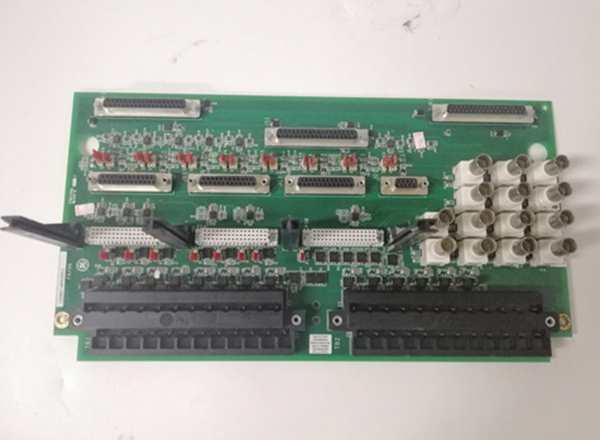
IS200EISBH1A
Related Model Recommendations
IS200EPBPG1A: GE’s excitation power backplane gateway module—receives aggregated I/O data from IS200EISBH1A via the EX2100 I/O Bus and routes it to the EX2100’s core control components.
IS200ERIOH1A: GE’s excitation regulator I/O module—complements IS200EISBH1A by handling centralized I/O signals in the control cabinet, while IS200EISBH1A manages distributed nodes.
IS200ERGTH1A: GE’s temperature and health monitoring module—connects to IS200EISBH1A as a remote I/O node to transmit temperature data from critical components (e.g., turbine bearings) to the EX2100 system.
IS200EPDMG1B: GE’s excitation power distribution module—supplies redundant 24 V DC power to IS200EISBH1A and its remote I/O nodes, ensuring uninterrupted signal aggregation.
IS200COMMG1A: GE’s communication expansion module—adds Profibus DP support to IS200EISBH1A for plants using legacy Profibus-enabled field devices.
IS200ERRBG1A: GE’s excitation redundant backplane—pairs with IS200EISBH1A to provide a second bus path for high-availability systems (e.g., nuclear power auxiliaries), ensuring no single bus fault disrupts I/O data flow.
IS200RTU100: GE’s remote I/O node—works with IS200EISBH1A to collect signals from up to 16 field devices per node, extending IS200EISBH1A’s reach in large facilities.
IS200JGPAG1A: GE’s dual-mode power module—serves as a backup 24 V DC source for IS200EISBH1A in remote locations where primary power is unstable (e.g., mountain hydro plants).
Installation & Maintenance Instructions
Installation Preparation
Before installing IS200EISBH1A, verify compatibility with your EX2100 system (firmware ≥5.0) and confirm the number of remote I/O nodes (max 16) to ensure the module can handle your facility’s signal load. Choose a mounting location based on your setup: for centralized deployment, install it in the EX2100 chassis (align with the designated slot and push until it clicks); for remote deployment, use DIN rail mounting (ensure the rail is secured to a stable surface and the module is clipped firmly into place).
Power off all related systems and follow lockout/tagout procedures. Use an anti-static wristband and ESD mat when handling IS200EISBH1A—its bus communication circuitry is sensitive to electrostatic discharge. Required tools: Phillips #2 screwdriver (for chassis access), torque wrench (0.2–0.4 N·m for terminal blocks), multimeter (to test power inputs), and bus cable crimper (for Modbus/EX2100 I/O Bus connections). Connect the redundant 24 V DC power inputs (red to positive, black to negative) and bus cables: use shielded twisted-pair cable for Modbus RTU (max 1 km) and Cat5e or higher for Ethernet (Modbus TCP, max 100 m). Verify isolation resistance between bus channels and ground (≥150 MΩ) with a megohmmeter before powering on.
Maintenance Guidelines
Perform monthly remote diagnostics of IS200EISBH1A via the EX2100 controller or DCS: check the status of all 16 remote I/O nodes (ensure “online” status), monitor bus communication speed (should remain stable at 1 Mbps/100 Mbps), and review fault logs (no unexpected disconnections or protocol errors). Every 3 months, conduct on-site inspections: for chassis-mounted modules, clean dust from vents with compressed air (held 15 cm away); for DIN rail-mounted units in harsh environments (e.g., turbine halls), inspect the conformal coating for cracks and wipe down the module with a dry cloth to remove dust or oil.
Semi-annually, test bus redundancy (if paired with IS200ERRBG1A) by disconnecting the primary bus cable—confirm IS200EISBH1A switches to the backup path in <100 ms, with no data loss. Calibrate analog I/O signals annually by connecting a standard signal generator to a remote node and verifying that IS200EISBH1A transmits the correct value to the EX2100 system (tolerance ±0.1%). If IS200EISBH1A fails to detect a remote node, first check the node’s power and bus cable (replace if damaged) before resetting the module via the EX2100 software. Always use genuine GE replacement parts if the module requires repair to maintain warranty coverage and protocol compatibility.
Service & Guarantee Commitment
IS200EISBH1A comes with GE’s industry-leading 3.5-year manufacturer’s warranty—matching the coverage of IS200EPBPG1A—covering defects in materials, workmanship, bus communication performance, and isolation integrity. GE guarantees that IS200EISBH1A will maintain stable communication with up to 16 remote nodes and provide ±0.1% analog signal accuracy for the warranty period, with free expedited replacement (24-hour shipping for critical power applications like nuclear auxiliaries) if it fails to meet these standards.
Customers gain access to GE’s Global Excitation Support Network for IS200EISBH1A, including 24/7 phone/email assistance from bus protocol experts, remote troubleshooting via secure VPN (to diagnose node connectivity or protocol conversion issues), and online training on
Full 12-month warranty on all components
Dedicated after-sales support
Same-day dispatch on 1000s of parts
All units are fully tested
- 1. Email confirmation
You will get an email confirming that we have received your enquiry. - 2. Dedicated Account Manager
One of our team will be in touch to confirm your part(s) specification and condition. - 3. Your quote
You will receive a comprehensive quote tailored to your specific needs.
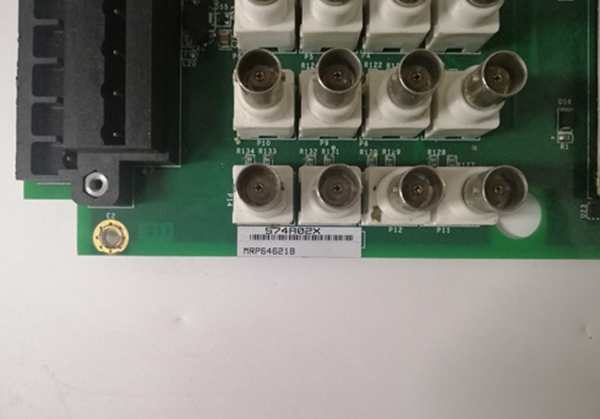
 Full 12-month warranty
Full 12-month warranty Available for dispatch immediately
Available for dispatch immediately We deliver worldwide
We deliver worldwide Full 12-month warranty on all components
Full 12-month warranty on all components